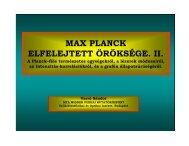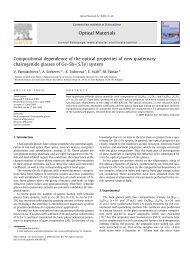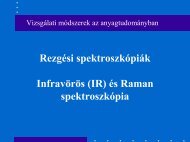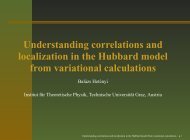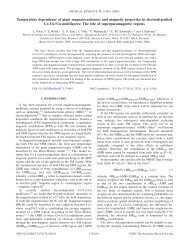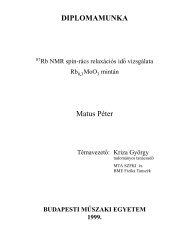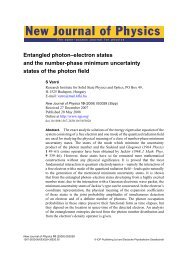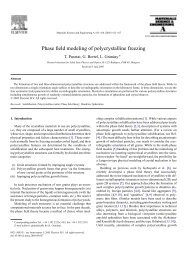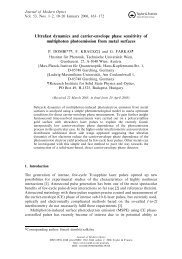ANNUAL REPORT - MTA SzFKI
ANNUAL REPORT - MTA SzFKI
ANNUAL REPORT - MTA SzFKI
You also want an ePaper? Increase the reach of your titles
YUMPU automatically turns print PDFs into web optimized ePapers that Google loves.
S. CHARACTERIZATION AND POINT DEFECT STUDIES<br />
OF OPTICAL CRYSTALS<br />
L. Kovács, I. Bányász, G. Corradi, I. Hajdara # , E. Hartmann, K. Lengyel, L. Malicskó, G.<br />
Mandula, A. Watterich<br />
Electron beam microanalysis on yttrium aluminum borate (YAB) crystals. ⎯ The<br />
impurity elements playing a dominant role in the formation of as-grown imperfections of<br />
YAB crystals growing from potassium trimolybdate melt-solutions undoped or doped with<br />
trivalent ions, were identified by energy dispersive X-ray spectrometry in a scanning<br />
electron microscope. These impurity elements were: Mo, K, Si, Ti and Ca.<br />
Computer modelling of defects in LiNbO 3 . ⎯ Using a recently derived interatomic<br />
potential, intrinsic and extrinsic defect formation energies have been calculated for<br />
LiNbO 3 and used to calculate the energies of defect reactions giving rise to the<br />
experimentally observed lithium deficiency in the material. Of these reactions, the<br />
formation of antisite niobium ions compensated by lithium vacancies was found to have<br />
the lowest energy, and this is therefore the predicted intrinsic defect model. Doping of a<br />
wide range of divalent and trivalent cations into the material was also considered, and<br />
predictions were made of the lowest energy sites for occupation, and the corresponding<br />
charge compensation schemes.<br />
Microscopic and Raman spectroscopic investigation of the domain structures in<br />
LiNbO 3 :Y:Mg crystals. ⎯ Formation of periodic domain structures in Mg and Y doped<br />
and Mg+Y co-doped congruent LiNbO 3 single crystals grown by an off-centred<br />
Czochralski method in the X and 148 o Y pulling directions has been investigated by<br />
Raman spectroscopic measurements. A band attributed to the E(TO 9 ) vibrational mode<br />
occurred at about 610 cm -1 in the Raman spectra recorded in Z(YY)Z backscattering<br />
geometry after chemical etching of a PPLN crystal grown in the X pulling direction. The<br />
shift of the E(TO 8 ) band position at the domain boundaries can be explained by the growth<br />
of the intensity of the E(TO 9 ) band. It was demonstrated by time dependent etching<br />
measurements that the increase of the E(TO 9 ) band is a consequence of periodic step-like<br />
forms on the surface of the crystal.<br />
Holography in LiNbO 3 crystals and silver halide emulsions. –– We developed and<br />
optimised a thermal treatment system and method for dehydrating and homogenising the<br />
oxidation state of lithium niobate crystals with different compositions. The hydrogen<br />
concentration was reduced by about two orders of magnitude in iron or manganese doped<br />
congruent and nearly stoichiometric samples, as compared to the as-grown state. Using<br />
this method we successfully prepared dehydrated 6 LiNbO 3 :Fe samples (at about 95% of<br />
6 Li) for the investigation of thermal neutron dosimeter applications. Such dehydrated<br />
samples were also used to test the holographic scattering method for the determination of<br />
the hydrogen concentration.<br />
We adapted the FRIINT program, developed at the Department of Physics of the Budapest<br />
University of Technology and Economics (BME), for the evaluation of the interferograms<br />
obtained by interference microscopic studies of holographic gratings in Fe-doped LiNbO 3<br />
crystals.<br />
The processing of silver halide holographic emulsions, fabricated by the Slavich Company<br />
(Russia), has been optimised for recording holograms of the LiNbO 3 crystals. These<br />
# Ph.D. student<br />
80



